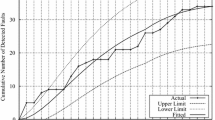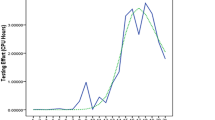Abstract
We observe a phenomenon that the probabilistic characteristic of software failure-occurrence time-interval change notably in an actual testing-phase of a software development process. Testing-time observing such phenomenon is ordinarily called change-point. This phenomenon is treated as one of the factors affecting the accuracy of software reliability assessment based on a software reliability growth model. And regarding software reliability growth modeling, a bivariate software reliability growth model, which describes a software reliability growth process depending on the software reliability growth factor consists of testing-time and testing-effort factors, has been proposed for improving software reliability assessment accuracy based on the software reliability growth process. In this paper, we develop a bivariate software reliability growth model considering with the uncertainty of the change of software failure-occurrence phenomenon at the change-point for improving more the accuracy. Finally we show numerical examples of our model by using actual data.




Similar content being viewed by others
Abbreviations
- SRGM:
-
Software reliability growth model
- NHPP:
-
Non-homogeneous Poisson process
- MSE:
-
Mean squared error
- \(F( {s,u} )\) :
-
Bivariate probability distribution function depending on the testing-time \(s\) and the testing-effort \(u\)
- \(N_0\) :
-
Random variable representing the initial fault content
- \(N( {s,u} )\) :
-
Two-dimensional counting process representing the total number of faults detected up to testing-time \(s\) and testing-effort \(u\)
- \(X_i\) :
-
Testing-time factor between the \(i\)th and (\(i-1\))st software failure-occurrence before change-point
- \(Z_i\) :
-
The \(i\)th software failure-occurrence time before change-point
- \(M_i\) :
-
Testing-time factor between the \(i\)th and (\(i-1\))st software failure-occurrence after change-point
- \(C_i\) :
-
The \(i\)th software failure-occurrence time after change-point
- \(Y_i\) :
-
Testing-effort expenditure between the \(i\)th and (\(i-1\))st software failure-occurrence before change-point
- \(W_i\) :
-
Testing-effort factor expended up to the \(i\)th software failure-occurrence time before change-point
- \(K_i\) :
-
Testing-effort expenditure between the \(i\)th and (\(i-1\))st software failure-occurrence after change-point
- \(D_i\) :
-
Testing-effort factor expended up to the \(i\)th software failure-occurrence time after change-point
- \(\lambda _s\) :
-
Testing-environmental coefficient being related to the testing-time factor
- \(\lambda _u\) :
-
Testing-environmental coefficient being related to the testing-effort factor
- \({\Lambda }( {s,u})\) :
-
Mean value function of the two-dimensional NHPP
- \({\Lambda }_B \left( {s,u} \right) \) :
-
Mean value function of the two-dimensional NHPP before change-point
- \({\Lambda }_A \left( {s,u} \right) \) :
-
Mean value function of the two-dimensional NHPP after change-point
- \(M\left( {s,u} \right) \) :
-
Expected number of remaining faults at testing-time \(s\) and testing-effort \(u\)
- \(\hbox {E}{[} {\cdot } {]}\) :
-
Expectation
- \(R(\eta |s_e ,u_e )\) :
-
Operational software reliability function, i.e., the probability that a software failure does not occur in the time-interval \(\left( {s_e ,u_e +\eta } \right) \left( {s_e \ge 0,u_e \ge 0} \right) \) given that the testing has been going up to testing-time \(s_e\) and the testing-effort has been expended up to \(u_e\)
- \({\Phi }\) :
-
Set of software reliability parameter
- \(\tau \) :
-
Set of change-point
References
Almering, V., Genuchten, M. V., Cloudt, G., & Sonnemans, P. J. M. (2007). Using software reliability growth models in practice. IEEE Software, 24(6), 82–88.
Chang, Y. P. (2001). Estimation of parameters for nonhomogeneous Poisson process software reliability with change-point model. Communications in Statistics - Simulation and Computation, 30(3), 623–635.
Gumbel, E. J. (1960). Bivariate exponential distributions. Journal of the American Statistical Association, 55, 698–707.
Huang, C. Y. (2005a). Performance analysis of software reliability growth models with testing-effort and change-point. Journal of System and Software, 76(2), 181–194.
Huang, C. Y. (2005b). Cost-reliability-optimal release policy for software reliability models incorporating improvements in test efficiency. Journal of System and Software, 77(2), 139–155.
Huang, C. Y., & Hung, T. Y. (2010). Software reliability analysis and assessment using queueing models with multiple change-points. Computers & Mathematics with Applications, 60(7), 2015–2030.
Huang, C. Y., & Lin, C. T. (2010). Analysis of software reliability modeling considering testing compression factor and failure-to-fault relationship. IEEE Transactions on Computers, 59(2), 283–288.
Inoue, S., & Yamada, S. (2007) Software reliability measurement with change-point. In Proceedings of the fifth international conference on quality and reliability (ICQR2007), Chiang Mai, Thailand, November 5–7, 2007 (pp. 170–175).
Inoue, S., & Yamada, S. (2007). Discrete program-size dependent software reliability assessment: Modeling, estimation, and goodness-of-fit comparisons. IEICE Transactions on Fundamentals of Electronics, Communications and Computer Sciences, E90–A(12), 2891–2902.
Inoue, S., & Yamada, S. (2008). Optimal software release policy with change-point. In Proceedings of the 2008 IEEE international conference on industrial engineering and engineering management, Singapore, December 8–11, 2008, CD-ROM (IEEE Catalog Number: CFP08IEI-CDR) (pp. 531–535).
Inoue, S., & Yamada, S. (2009). Two-dimensional software reliability measurement technologies. In Proceedings of the 2009 IEEE international conference on industrial management and engineering management, Hong Kong, China, December 8–11, 2009 (pp. 223–227).
Inoue, S., & Yamada, S. (2011). Software reliability measurement with effect of change-point: Modeling and Application. International Journal of Systems Assurance Engineering and Management, 2(2), 155–162.
Ishii, T., & Dohi, T. (2006). Two-dimensional software reliability models and their application. In Proceedings of 12th Pacific rim international symposium on dependable computing (pp. 3–10).
Joe, H. (1989). Statistical inference for general-order-statistics and nonhomogeneous-Poisson-process software reliability models. IEEE Transactions on Software Engineering, 15(11), 1485–1490.
Langberg, N., & Singpurwalla, N. D. (1985). A unification of some software reliability models. SIAM Journal on Scientific Computing, 6(3), 781–790.
Lin, C. T., & Huang, C. Y. (2008). Enhancing and measuring the predictive capabilities of testing-effort dependent software reliability models. Journal of Systems and Software, 81(6), 1025–1038.
Miller, D. S. (1986). Exponential order statistic models of software reliability growth. IEEE Transactions on Software Engineering, SE–12(1), 12–24.
Musa, J. D., Iannio, D., & Okumoto, K. (1987). Software reliability: measurement, prediction, application. New York: McGraw-Hill.
Ohba, M. (1984). Software reliability analysis models. IBM Journal of Research and Development, 28(4), 428–443.
Pham, H. (2000). Software reliability. Singapore: Springer.
Raftery, A. E. (1987). Inference and prediction for a general order statistic model with unknown population size. Journal of the American Statistical Association, 82(400), 1163–1168.
Shyur, H. J. (2003). A stochastic software reliability model with imperfect-debugging and change-point. Journal of Systems and Software, 66(2), 135–141.
Yamada, S. (2013). Software reliability modeling: fundamentals and applications. Tokyo: Springer.
Yamada, S., & Osaki, S. (1985). Software reliability growth modeling: Models and applications. IEEE Transaction on Software Engineering, SE–11(12), 1431–1437.
Zhao, M. (1993). Change-point problems in software and hardware reliability. Communication in Statistics - Theory and Methods, 22(3), 757–768.
Zou, F. Z. (2003). A change-point perspective on the software failure process. Software Testing, Verification and Reliability, 13(2), 85–93.
Zhao, J., Liu, H. W., Cui, G., & Yang, X. Z. (2006). Software reliability growth model with change-point and environmental function. Journal of System and Software, 79(11), 1578–1587.
Acknowledgments
This research was partially supported by the Grant-in-Aid for Scientific Research (C), Grant Nos. 25330081 and 25350445, from the Ministry of Education, Culture, Sports, Science and Technology of Japan and The Telecommunications Advancement Foundation.
Author information
Authors and Affiliations
Corresponding author
Rights and permissions
About this article
Cite this article
Inoue, S., Ikeda, J. & Yamada, S. Bivariate change-point modeling for software reliability assessment with uncertainty of testing-environment factor. Ann Oper Res 244, 209–220 (2016). https://doi.org/10.1007/s10479-015-1869-6
Published:
Issue Date:
DOI: https://doi.org/10.1007/s10479-015-1869-6




